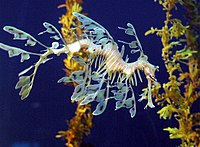
Photo from wikipedia
This study showed the genetic diversity and population structure of S. aureus presenting the same spa type, t899, but belonging to different STs. Our findings revealed that these isolates vary… Click to show full abstract
This study showed the genetic diversity and population structure of S. aureus presenting the same spa type, t899, but belonging to different STs. Our findings revealed that these isolates vary deeply in their core and accessory genomes, contrary to what is regularly inferred from studies using spa typing only. ABSTRACT Methicillin-resistant Staphylococcus aureus (MRSA) presenting spa type t899 is commonly associated with sequence type 9 (ST9) but is also increasingly linked to ST398. This study provides genomic insight into the diversity of t899 isolates using core genome multilocus sequence typing (cgMLST), single nucleotide polymorphism (SNP)-based phylogeny, and the description of selected antimicrobial resistance and virulence markers. The SNP-based phylogenic tree showed that isolates sharing the same spa type (t899) but different STs highly diverged in their core and accessory genomes, revealing discriminant antimicrobial resistance (AMR) and virulence markers. Our results highlighted the idea that in a surveillance context where only spa typing is used, an additional multiplex PCR for the detection of the tet(M), sak, and seg genes would be valuable in helping distinguish ST9 from ST398 isolates on a routine basis. IMPORTANCE This study showed the genetic diversity and population structure of S. aureus presenting the same spa type, t899, but belonging to different STs. Our findings revealed that these isolates vary deeply in their core and accessory genomes, contrary to what is regularly inferred from studies using spa typing only. Given that identical spa types can be associated with different STs and that spa typing only is not appropriate for S. aureus isolates that have undergone major recombination events which include the passage of the spa gene (such as in t899-positive MRSA), the combination of both MLST and spa typing methods is recommended. However, spa typing alone is still largely used in surveillance studies and basic characterization. Our data suggest that additional markers, such as tet(M), sak, and seg genes, could be implemented in an easy and inexpensive manner in order to identify S. aureus lineages with a higher accuracy.
Journal Title: Applied and Environmental Microbiology
Year Published: 2021
Link to full text (if available)
Share on Social Media: Sign Up to like & get
recommendations!